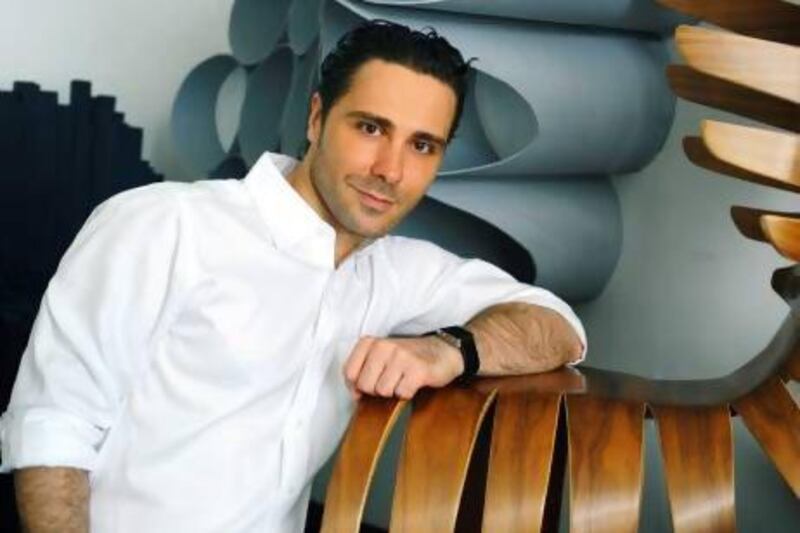On his Dubai debut, one of Italy's most prolific designers tells Selina Denman why nature is the cornerstone of his creations
Antonio Pio Saracino is no stranger to international accolades. He has been hailed as one of Italy's top 10 architects by the New Italian Blood award, one of the world's 25 most interesting trendsetters by New York's ARTnews magazine, is the winner of four of Interior Design magazine's Future Furniture Awards and a recipient of the American Architecture Award from the Chicago Museum of Architecture.
After a career that has already seen him create buildings, monuments, furniture and lighting, as well as the trophy for the 2010 Formula One and MotoGP World Championship, he recently made his Dubai debut.
In partnership with Design Days Dubai, and as part of Bloomingdale's Dubai's Celebrate the Worldcampaign, Saracino was invited to create an exclusive, interactive, in-store installation. The resultant work, City Within, will be on show in the Dubai Mall store until April 16.
"I had never been to the UAE and I liked the idea of creating something for this international design fair that could be experienced in a luxury retail environment like Bloomingdale's," Saracino says.
The installation consists of a series of lightweight, translucent polycarbonate sheets that have been hung up to create the shape of "a complex volume", Saracino explains. His inspiration for the project was equally complex - and cerebral.
"The City Within installation is a metaphor of the contemporary digital city that is not made with a tangible space," he says. "It conveys the idea of an ephemeral city versus the physical city. The empty space inside the installation is originated from carving out the shape of a dimensional city landscape and presents a visual experience for visitors that pass by or those that wish to engage by visiting the space inside the installation. The many surfaces composing the installation display images of my design work, from chairs to buildings."
Pieces by Saracino were also showcased at Design Days Dubai, courtesy of the US-based Industry Gallery and Milan's Erastudio. For Saracino, the fair was an exciting reflection of Dubai's standing in the design world.
"I felt that Design Days Dubai was a truly international platform representing designs and designers from all over the world. The fair reflected the international spirit of Dubai, a city at the crossroads between the Eastern and Western worlds. Architects from all over the world have contributed in making Dubai a city of the third millennium and the city has gained worldwide attention over the past few years because of its booming economy and ambitious architectural projects."
Bloomingdale's Dubai also became the first store in the world to stock Saracino's Star furniture. Star, one of the designer's first commercial collections, consists of a chair and coffee table, and made its première in Dubai at the end of March.
"The Star Collection is among my first furniture collections for mass production," Saracino explains. "The collection is an exploration of the Star morphology applied to a chair and a coffee table. The points of the star extend from a core and become the legs, the seat, the back and the arms of the chair. The thin aluminium sheet is bent to strengthen the star section and it is hand-welded and polished. The chairs are available in different colours and with an optional leather cushion. The coffee table is built with eight rays that build a dimensional star holding a glass tabletop," he says.
While Saracino currently divides his time between New York and Rome, he grew up, surrounded by nature, in a small town in southern Italy. A childhood fascination with the natural world evolved into a cornerstone of his design aesthetic, and while he is always keen to make clear that he is not trying to replicate nature in his work, he does try to capture and recreate the emotions that nature evoke in him.
"Design is the place of continuity between humans and nature; it is a place of integration with nature. Good design is intuitive, universal and timeless. It creates an empathetic bond with humans both functionally and aesthetically," he says.
In addition to paying homage to the natural world, Saracino's furniture is unashamedly sculptural. His Ray sofa and chair are crafted from prism-shaped pieces of foam that have been linked and then shrink-wrapped together. The resultant silhouette calls to mind the Manhattan skyline. The Cervo chair is made from a continuous sheet of plywood curved into opposing concave and convex shapes. The plywood is almost unfathomably thin, so the chair becomes a testimony to the strength of the material while taking on a natural, almost skeletal form.
Saracino studied at La Sapienza University of Architecture in Rome and graduated cum laude with a master's degree in 2003. He has worked with Italian and US architectural firms, including Rome's Massimiliano Fuksas, and since 2004, has collaborated with the New York-based architect Steve Blatz.
His arrival in Rome as an impressionable 19-year-old compounded his appreciation of the power of design and its role in shaping and defining civilisations. Tellingly, the Pantheon in Rome is still his favourite building. "I have always been interested in design and architecture because they represent the most powerful and interesting activity that we have in defining our place within the natural world," he says.
"I love designing objects that people will use and buildings that people will inhabit. What I love most about my job is creating something that might inspire and touch other people's lives."






